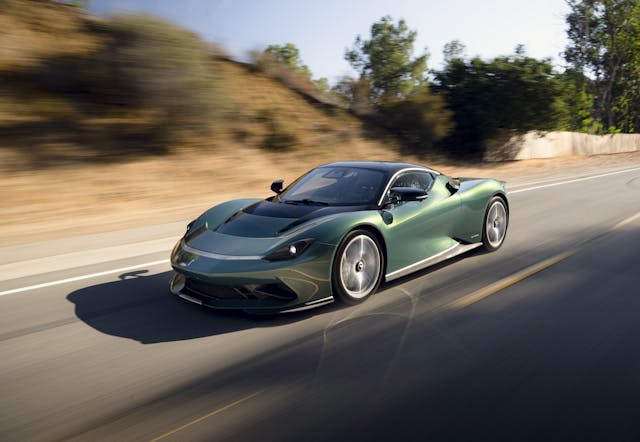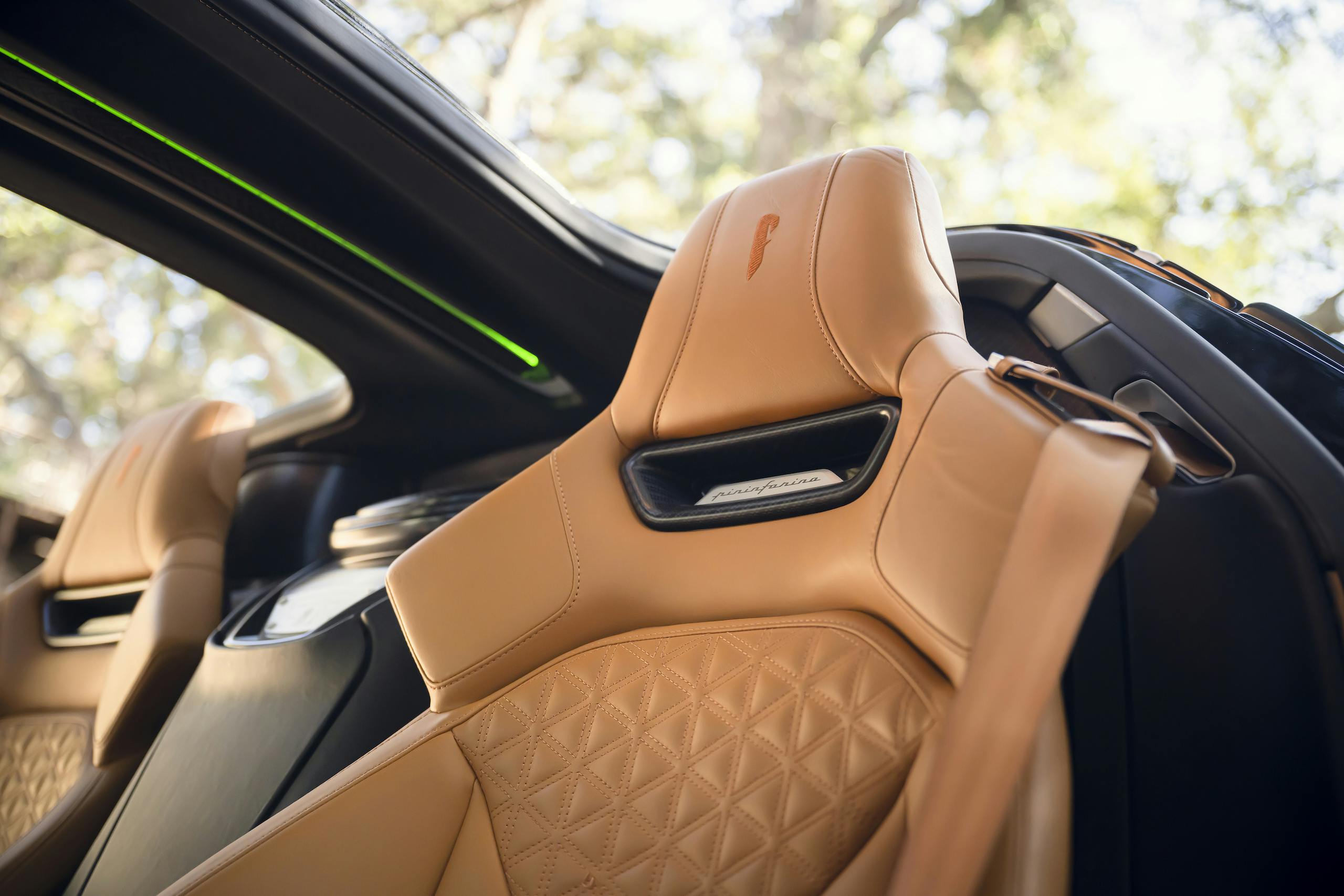Pininfarina Battista Review: $2M electric hypercar goes hard on tech, soft on design
If you’re able to stroke a check for $2 million, an Italian couturier with nearly a century of design hits will build you a svelte, graceful, and opulent two-seat sex wedge with almost 2000 horsepower. Its acceleration, quoted as “less than 2.0 seconds” to 60, will be dangerous to cardiac patients and send major organs yo-yoing on their strings. Wherever one of the 150 planned copies goes, there will be curiosity, questions, and admiration. And once again there will be proof that the world never stops running out of good reasons to be rich.
You remember the Pininfarina badge from your favorite Ferraris of yore. Founding father Battista “Pinin” Farina formed his illustrious carrozzeria in 1930 and got down to business with Ferrari starting in the early ‘50s. Well, the glory days of independent Italian design houses is well past—Ferrari stopped putting Pininfarina badges on its cars with the 2012-2017 F12—and those that survive are now scrambling for a buck doing whatever consulting and design work they can lay hands to.
As of 2015 a subsidiary of the Indian industrial conglomerate Mahindra, Pininfarina spun off a separate company in 2018, Automobili Pininfarina, based in Munich (and also primarily owned by Mahindra). The mission is to build and sell cars bearing the Pininfarina badge right on the nose, rather than down at the sides where bodymakers traditionally get their stamp. The move into whole-car production is seen as the final fulfillment of Pininfarina’s original vision. “Battista always wanted to make his own cars,” says Automobili Pininfarina chief design officer Dave Amantea. “He was once offered a job to head design at Ford, and he turned them down to pursue his dream.”

However, Battista, for whom the new car is named, never quite got that far, spending his years bejeweling the showrooms of other automakers. And these days it’s no small trick to produce a reliable and legally compliant car. For one thing, it pretty much has to be electric; that is the way the whole automotive industry, and especially the hypercar niche, is headed. Unless you’re Gordon Murray and then you can do whatever the hell you want. But the V-12-powered, manual-transmission T.50 aside, it’s now obvious to everyone that electrics will drop-kick any internal-combustion car into next week on acceleration, and let’s be honest, hypercars are all about the fast.
This one may even sell out fast. Pininfarina says its nine dealers in the U.S. and Canada have already packed the order book. The first five retro-themed blue-and-white Annversario cars are taken, and interested parties are encouraged to “be quick if you want one,” as the whole 150-car run is expected to be done by 2024.
To get a car out so quickly after the company was formed, Automobili Pininfarina inked a co-development deal with Croatia-based Rimac, the electric supercar startup that last year embarked on a joint venture with Volkswagen and Porsche AG to take over the Bugatti brand. Despite the pandemic, the war in Ukraine, and all the other upheaval since, the two companies, Rimac and Pininfarina, have produced effectively one car in two versions.
The similarly expensive (and heavy, at over 5000 pounds) Rimac Nevera and the Pininfarina Battista start in Croatia as a common chassis with a carbon-fiber tub, T-shaped 120 kW/hour battery said to be good for 300 miles, four-motor torque-vectoring drivetrain, and electrical architecture. From there they diverge, embryonic Battistas heading to Pininfarina’s operation in Cambiano, near Turin, for the company’s special slathering of opulence, Italiano-style. Customers are invited to come to Cambiano and personally customize their Battistas with help from the firm’s designers, creating their own interior and exterior color combinations, materials, engravings, and appointments. Amantea figures there are 128 million possible combinations, meaning no two of the 150 cars will be alike unless it’s done on purpose.

Pininfarina furnished us to drive for a few hours in the car pictured here and painted a shade of opalescent green it calls “verde paradiso.” The color is “inspired by the color of Lake Como,” according to the car’s chief production and engineering officer, Paolo Dellacha. The shape, which includes a rear wing that deploys at speed to augment the car’s downforce-producing aero, is a touch generic. At a quick glance it reads like any one of several mid-engine pop-rockets that you can buy from Ferrari or McLaren. Which feels like a missed opportunity considering the car bears prominently the name of an illustrious carrozzeria that designed everything from pre-war Lancia stunners to the Ferrari Modulo. No doubt the firm’s hands were tied somewhat by its relationship with Rimac and the need for common hardpoints.
The Battista’s cockpit shows more adventuresome thinking with its brace of info screens and machine-milled rotary knobs for the PRNDL and drive-mode selection. As you would expect, the detailing is exquisite, down to the orderly herringbone pattern of the naked carbon fiber and the unusual stitch patterns in the chairs (if you don’t like them, opt for something else). Entering and exiting is fairly easy; the door swings up and out on a wide arc revealing a relatively slender sill to slide over.
Once ensconced, however, the visibility to the rear quarters is virtually non-existent. (Surprising, given there is no engine and associated plumbing behind you to cloud the view.) Backup and surround-view cameras, which were non-functional on the prototype we drove, will be vital tools to preserving the paint job. There is a small cargo area in back; opting for Pininfarin’as bespoke luggage is essential, as it will drop in more neatly than your battered American Tourister.
The four UK-sourced permanent-magnet AC electric motors deliver a combined 1726 pound-feet of torque, but each turn a wheel separately. That offers virtually unlimited fore-aft and side-to-side torque adjustment as well as torque vectoring and, ideally, ultra-refined stability management. Want to go sideways, but only just so much? Or horribly overcook a corner but still stick the apex? This system should be able to do it at the push of a button. Welcome to the future, where everyone is a robot-assisted Fangio.

The driver can select a flavor of power delivery, as well as steering and dampener stiffness, from one of five modes with increasing levels of spiciness. There’s Calma (calm), Pura (pure), Energica (energetic), Furiosa (just guess), and Caratterre (character). The latter offers individual settings for the stability control, steering heft, and damper stiffness as well as noise. There’s both an interior and exterior sound system, the former to provide the driver some aural feedback—sound, the engineers feel, is a sense that is important, even necessary, in driving—and the exterior to warn pedestrians and give the car a curbside personality. Kneel down by the bumper and you’ll hear hidden speakers pulsating at “idle,” emitting a combination of simulated turbine whoosh and a rhythmic thump-thumping that the designers liken to the beating heart of an animal. A finely-tuned exhaust sound has been a trademark characteristic of hypercars, and so will it be in the future, albeit with speakers and custom programming.
The Battista defaults to Pura on startup and that’s a fine mode to do most of your driving in, though the regen is still fairly aggressive and one-pedal driving is possible. If you need to stab the brake, 15.4-inch Brembo carbon-ceramic discs are at the pedal’s command, waiting patiently for those pull-downs from 200 mph that will come but rarely in a Battista’s life. Most of the time they’ll be four stone-cold plates in city traffic as the motors efficiently eat up the car’s kinetic energy and convert it to juice for the pack.
The car has plenty of road-hugging weight, as they used to say, but in typical EV fashion it’s relatively low in the car, acting as more of a keel than a pendulum against excessive roll. Thus, despite the extra 1500 or so pounds over a comparable McLaren, the Battista eats a twisty road with reactive steering responses and plenty of grip, the suspension controlling the motions of all that avoirdupois with commendable restraint. Any deeper investigation of the promised torque-vectoring capability would have required some track time; if it was working, it was mostly transparent to the driver.
We found the car’s controls overly assisted and the steering remote. Not much feedback comes up the column and it’s easy to overcorrect in the normal course of trying to keep the car between the lines. On a particularly tight and gnarly stretch of canyon road, we switched into Furiosa and felt the front end go completely light, the turning grip seeming to have melted away. It caught us by surprise, given that’s supposed to be the corner-killer mode, so we quickly went back to Pura, our favorite. Maybe the torque vectoring wasn’t so transparent after all, and perhaps the software in that mode is still being baked.

You can’t give this thing much more than 20 percent accelerator unless you’ve sent a police escort up the road in advance to block intersections and clear away any nuisance traffic. Car writer types have been trying to come up with superlatives to describe fast acceleration since the Hudson Hornet—and have generally failed to produce literary achievement. So there’s no point in attempting to break a record here. However, if you’re familiar with the acceleration of a 1-liter superbike, in which it takes mere half-seconds to fling past a car on a two-lane, then the Battista is as quick or even quicker. It should be, with all things being equal (about 2 to 2.5 pounds per hp, give or take), as it possesses the advantage of four-wheel-drive and more tire on the road, plus instant torque and no transmission to shift. We used to think the 1200-hp Bugatti Veyron Super Sport was fast; it seems like a beached jellyfish compared to the Battista.
You have to warn your passenger before opening it up, lest their head get smacked from behind by the seat hard enough to erase memories. The fact that the Michelin Pilot Sport Cups can even hold on enough to transmit the Battista’s torque is a miracle of tire science. Don’t expect the rubber to live long if you’re heavy of foot. With electric cars, and hypercars in particular, we are approaching the point where more power simply can’t be transmitted to the asphalt to increase acceleration. Pininfarina’s eventual Battista replacement may have 1 million horsepower, but without rocket bottles it likely won’t be any quicker to 60. If it is, its occupants will be passed out.
Pininfarina and Rimac still have some work to do on the car. The electronics are not completely sorted on this very ambitious undertaking, and they need to be considering the car’s power source. Rimac is supposedly tied down by an exclusive development agreement with Porsche once the Battista production run is finished, so Pininfarina will have to grow its next car internally or seek another partner. Let’s hope the styling is a bit more adventurous. It seems right that if any car should break a mold or smash a convention, it should come bearing the badge of a famous Italian design house.
2023 Pininfarina Battista
Price: $2M+
Highs: Brutal acceleration, gorgeously detailed interior, 150-unit production limit ensures exclusivity.
Lows: Electronics need refinement, as does dynamic handling in certain modes. Styling is a little anodyne, especially for Pininfarina.
Takeaway: Like Brad Pitt or Jessica Chastain, nice to look at but the most interesting things are inside.
Check out the Hagerty Media homepage so you don’t miss a single story, or better yet, bookmark it.












